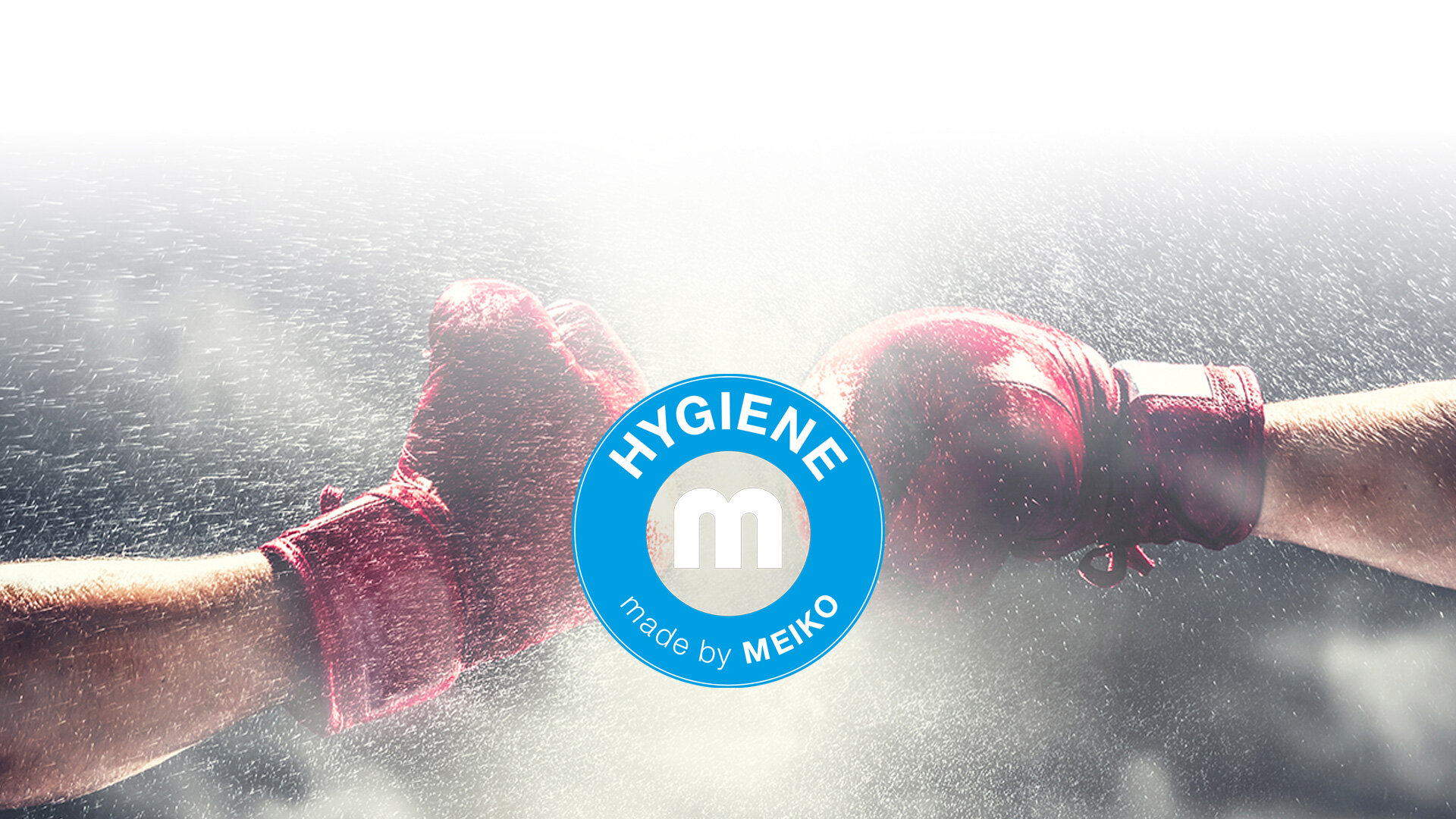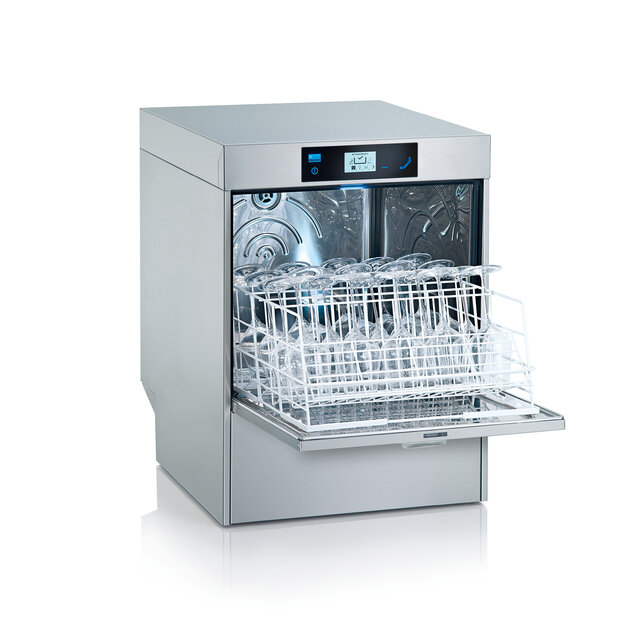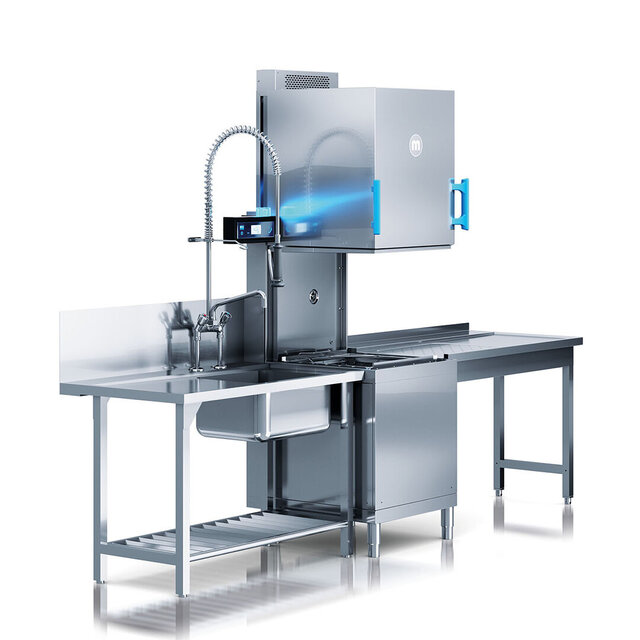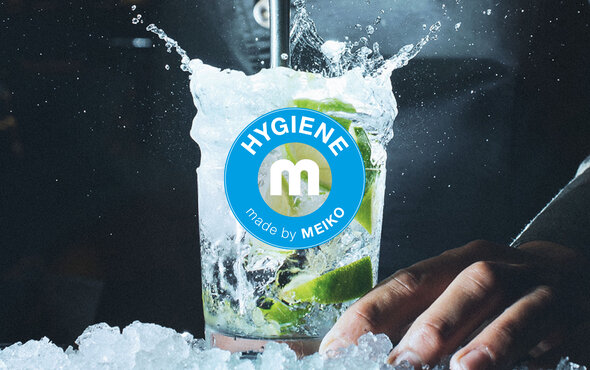In the red corner, it's the time-honoured method of washing-up that is still often observed today: washing glassware by hand.
And in the blue corner, it is the challenger for the title: the glasswasher!
What are the knockout criteria? Who has the unbeatable left hook?
Let’s get ready to rumble!
ROUND 1:
The warewashing process
MACHINE:
Glasses are collected in the rack and inserted into the dishwashing machine. The only thing left to do: press the start button.
The machine will automatically do the rest, with no further input from employees needed.
- The opportunity for human error is reduced to a minimum
- The length of wash cycle and all other parameters are set by the choice of programmes
- The wash process takes place inside the machine, i.e. in a closed system without releasing aerosols (extra-fine droplets that can spread pathogens through the air)
- Hygienic indoor climate thanks to reduced steam emissions using a MEIKO heat recovery system (AirConcept or ComfortAir)
- Assured, validated wash process with parameters that can be read out and evaluated
MANUAL:
Staff individually dip glasses into the wash water and wash them out with a brush or sponge, then swirl them in clear water and put them out for the next round of drinks. Tea towels may be used at this point.
The wash water has to be changed regularly and it has to be checked for chemical dosage and temperature.
- There is plenty of room for error
- Several actions are necessary to keep the area hygienic – at the cost of time and resources
- Aerosols and steam are released from the sink during the wash process – potentially spreading germs in the air throughout the entire room
- This is not an assured or validated process
ROUND 2:
Wash temperature
MACHINE:
The water temperature in glasswashers is 60 °C for the wash cycle and 65 °C for the rinse cycle.
- That is a high enough temperature to achieve clean, hygienically safe washing results
- Temperatures are kept constant by the double-walled construction which combats fluctuations
- The required temperature is met, otherwise the machine automatically extends the wash programme (run time extension)
MANUAL:
For manual washing, a water temperature of at least 45 °C is recommended.
- This does not assure hygienic wash results
- The temperature is too low to reliably inactivate certain viruses (this is only achieved above 60 °C) or to effectively remove certain substances (e.g. at least 55 °C is required for fats)
- A temperature increase cannot be tolerated because of skin exposure
- The temperature in the sink cannot be kept constant
ROUND 3:
Chemical agents
MACHINE:
The required detergent and rinse aid are automatically fed into the tank or boiler from the attached chemical canisters on every fill cycle.
- The correct dosing of the chemical agents is managed by the dishwashing machine
- Automatic process that takes place inside the machine
- Availability is always ensured (display notification provides information when chemical agents need to be refilled)
MANUAL:
Detergent and rinse aid must be added to the wash water by hand. Chemical dosing in the wash water must be checked at set intervals. In practice, it is doubtful that this is reliably carried out and, most importantly, at the correct dosing levels – especially in the rush of peak times.
- No option for constant monitoring of chemical dosing levels
- There is plenty of room for error
- If dosing is too high: skin is affected and an odor can build up in the glasses
- If dosing is too low: the chemical agents will not be effective enough (especially when contact is brief)
ROUND 4:
The washing mechanism
MACHINE:
Commercial dishwashers feature several programmes so the user can select one according to the degree of soiling on the dishes – then it will run reliably.
- Soft start to protect the glasses
- Viruses are reliably removed
- Wash programmes run automatically inside the machine
MANUAL:
How thoroughly and for how long an employee washes an item depends on many factors. Not least of which, how pressed for time he is.
- This can be negatively impacted by the environment (how hectic it is) and equipment (e.g. sponges)
- Hygiene risk: washing-up sponges (often carry high numbers of germs)
ROUND 5:
Wash time
MACHINE:
A glasswasher can wash up to 25 glasses in 90 seconds, depending on the size of the rack, the machine and the glasses.
- It can handle larger volumes of glassware than any human dish washer
- All at the push of a button – so employees can turn their attention to customers, to service or to other tasks
MANUAL:
The length of time required really depends on the employee – but a glasswasher with a capacity of 25 glasses every 90 seconds is simply unbeatable.
- Employees are busy with washing-up, thus they have no time to spend with customers
ROUND 6:
The drying process
MACHINE:
When the wash process ends, the rack of clean washware can be removed. It should be left to stand next to the dishwashing machine briefly so that the residual moisture evaporates while the glasses are still warm.
- No need to dry or polish – especially when using a MEIKO GiO MODULE (optional reverse osmosis system) and MEIKO AirConcept or ComfortAir (heat recovery systems which aid in drying washware)
- No effort from staff and therefore no staffing costs
- From our experience: 23% reduction in glass breakage
- Hygienically safe drying process
- No additional handling of tea towels
MANUAL:
Often, glasses are refilled and served again while they are still wet. Or they are left to drip dry. Sometimes tea towels are used to dry glasses before they are refilled.
- This requires extra space for storage, drip drying or towel drying
- Drying and polishing are very time consuming for employees
- Increased risk of glass breakages (33% per year)*
- Hygiene risk: tea towels (should be changed several times per day and used towels washed at least at 60 °C)
*Fries-Rack, a German warewashing equipment dealer, has worked out that 33% of glassware is broken every year in the food service sector. Polishing is the primary cause.
CONCLUSION:

Especially on hygiene safety, the comparison is clear: the glasswasher wins on points!
Manual washing-up just cannot keep pace. When washing manually, hygiene safety depends on the staff in the dishwashing area. Just a small deviation from procedure or lapse in attention can compromise hygiene.
This is not only true for washing glasses. It applies to all washware: plates, cutlery and other kitchen utensils.
The dishwashing machine wins hands down. A MEIKO dishwashing machine in particular will put you on the safe, hygienic side.
That is because we offer:
- Safety and hygiene for your customers:
an optimal combination of wash temperature, chemical agents, wash mechanism and wash cycle time to inactivate viruses such as the coronavirus and reliably remove spots – confirmed via expert opinion. - Safety and peace of mind for your business and employees:
pre-configured settings and processes run automatically at the push of a button – no further action from employees needed. - Authentic enjoyment and uncompromised flavour:
thanks to the effective wash mechanism and MEIKO features like AirConcept or ComfortAir (optional heat recovery systems) and the GiO MODULE (optional reverse osmosis system) that make drying and polishing a thing of the past.







